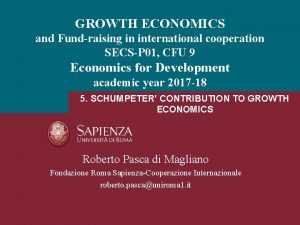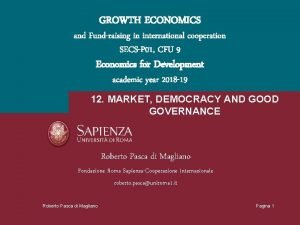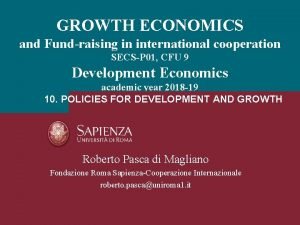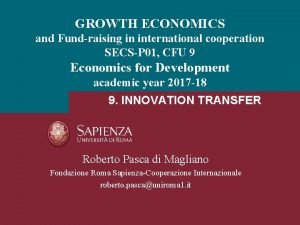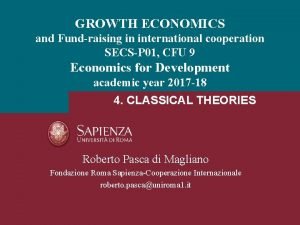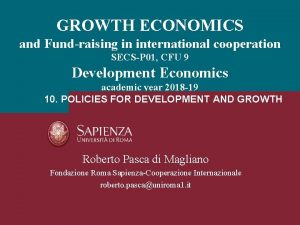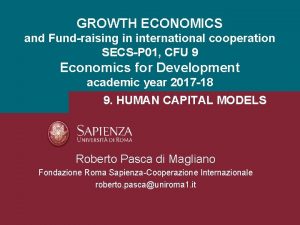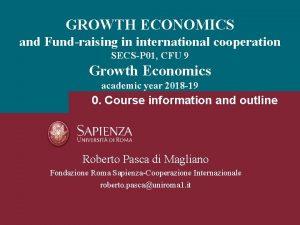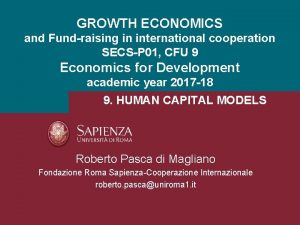GROWTH ECONOMICS and Fundraising in international cooperation SECSP











- Slides: 11

GROWTH ECONOMICS and Fund-raising in international cooperation SECS-P 01, CFU 9 Economics for Development academic year 2017 -18 3. INTRODUCTION TO GROWTH ECONOMICS Roberto Pasca di Magliano Fondazione Roma Sapienza-Cooperazione Internazionale roberto. pasca@uniroma 1. it

Differences between Development and Growth • • Development: newly-born backward countries after World War II development is a four-leg chair where institutional, social, civil and economic aspects are stabilised interdisciplinary studies Growth: dominance of the economy over the behavior of institutions and individuals Main aspects to be explained: explaining why growth is concentrated in a few countries, while many others are still waiting along the road explaining how some developing countries are redeemed and crowding the group of the emerging countries Explaining the dynamics that move the transition countries Roberto Pasca di Magliano 2017 -18 Pagina 2

Changes in the world GDP

The free market and its consequences • The consequence of the free market hypothesis is all too obvious: the market works well only if it is left free (hence the famous expression “laissez faire”) • Therefore, the market, not only does not need any help, but if anything, just needs to be freed of obstacles and regulations that might prevent its action • It is interesting to note that in this last consideration, one can find an argument that is often made in favour of the market, even nowadays: the market must be left free, it must not be caged but it needs a good governance Roberto Pasca di Magliano 2017 -18 Pagina 4

The role of the State in the economy • The founder of theory of the role of the State in the market is John Maynard Keynes as it has been analised in “General Theory of Employment, Interest and Money” 1936 • The innovative idea is that the role of the State is fundamental. Indeed, the market can, according to Keynes, produce results that are not optimal, and the State’s role is to help the market to work well and in a correct direction • The duty of the State is on the one hand to mitigate and control the economic cycles and on the other hand to bring the market to a better situation (especially in terms of unemployment, well-being) compared to the one that could make the market free to operate Roberto Pasca di Magliano 2017 -18 Pagina 5

Role of public policy We know that in the short run economy is influenced by aggregate demand public economic policies. So, during recession the State have to push aggregate demand towards the productive capacity of the economy. When the economic performance is influenced by factors erratically affecting production, employment, and inflation, Keynesian economists argue that private decisions sometimes could lead to inefficient macroeconomic outcomes which require active public policy responses in order to stabilize output over the business cycles. Main policies regard: Ø monetary policy actions by the Central bank Ø fiscal and budget policy actions by the Government Keynesian economics is then advocating a mixed economy system where the private sector continues to play an important role, even if they believe in an important role to be played by the State in recession periods. Roberto Pasca di Magliano 2017 -18 Pagina 6

The market in the face of crisis Origins of the financial crisis 2007/08 • Since the 1980 s, liberal pressures and the dissemination of new and revolutionary communication technologies –ICThave produced an enormous expansion of the financial activities at the international level with respect to real economy (10 to 1, nowdays) • The new technological revolution generates the so-called market globalization by generating advantages (icome-gap reducing among countries) but in the same time increasing many social disadvanteges (Income inequalities within each country, poverty increase, uncontrolled migration flows, social disease, market uncertainty) Ø Advantages evidence: begining 90 s, the international trade is grown continuosly, numebers of the emerging countries are increasing as well as their Gdp, Volume of financial investment, mergers and aquisitions are growing progressively due to mutual funds, pension funds and soverign wealth funds Ø Diastvantages evidence: allocations prefered financial products (derivatives, etc. ) other than real investment (that remain faible), inland poverty misallocation increased, underdevoped countries became even poorer Roberto Pasca di Magliano 2017 -18 Pagina 7

Financial Markets • The total value of financial activities is estimated at lest 10 times the real income • They move volumes of wealth built on the trade of derivatives and other products that are detached from economic activities, whereby every turbulence generates psychological repercussions not only on the stock markets but also on the loans to businesses • New financial allocation authorities are the investment banks and big investors who do not care about real economy • The concentration in the financial allocations causes growing concern for the small and medium enterprices in term of lack of investments • The perceptions of the market can be compared to an hypothetical scenarios of rising chain reactions in depressive direction Roberto Pasca di Magliano 2017 -18 Pagina 8

Reasons of the crisis started in 2007 • The crisis originated in 2007 was the result of a guilty lack of governance, representative of the liberal culture that was indulged in during the times in which the strong economic growth facilitated financial activities (Grennspan, Federal Reserve Bank) • Investment banks, and not only, have taken advantages of this, thrusting on much higher leverage ratios than those of the commercial banks, eventually bringing about the creation of high-risk financial products • Expansive policies adopted by advanced countries aftter 2015 (in Italy too) seem to be succeful in stimulating Gdp and in reducing the rate of unemployment Roberto Pasca di Magliano 2017 -18 Pagina 9

The actual crisis: EU response Ø Ø Ø Ø Ø Banking system approach: v v Public participation in the capitals of banks in crisis, provided it goes to fuel the loan supplies (bailout System) Private reforms and needs for stockholder to pay for that (bailin system) Need of Government guarantee both on deposits and interbank loans Lighten the regulatory capital requirements of Basel regulations Promoting cooperation agreements with Sovereign Wealth Funds to increase real investments Need to revise the tight discipline of the Maastricht Treaty to improve flexibility in the budgetary constraints even if within a sustainibility trend Boost the demand, by reducing the tax burden on families, in order to send a strong signal to the recovery of purchasing power Review the rules regulating the financial and stock markets in order to fight the speculative designs that preceed the speculation over the economic and patrimonial consistency of businesses Lower the minimum requirement for the public purchasing offer in businesses to avoid hostile participations Maintain the European Stability Mechanism (ESM) and other monetary policies to support inflation rate Roberto Pasca di Magliano 2017 -18 Pagina 10

Following lectures in details Ø From theories to models Ø Classical theories of development Ø The Keynesian growth model of Harrod-Domar Ø Neo-classical models of growth: Solow approach Ø Analysis of growth based on the production function Ø The new endogenous growth theory (NTC) and macrodeterminants of growth
 Secsp
Secsp Donorperfect fundraising growth platform integrations
Donorperfect fundraising growth platform integrations Mena gainpaulsingh
Mena gainpaulsingh Ilac mra
Ilac mra Working group on international cooperation
Working group on international cooperation International laboratory accreditation cooperation
International laboratory accreditation cooperation Principles and techniques of fundraising
Principles and techniques of fundraising Principles and techniques of fundraising
Principles and techniques of fundraising School of business and economics maastricht
School of business and economics maastricht Growth is defined as an increase in
Growth is defined as an increase in Monocots eudicots
Monocots eudicots Primary growth and secondary growth in plants
Primary growth and secondary growth in plants
